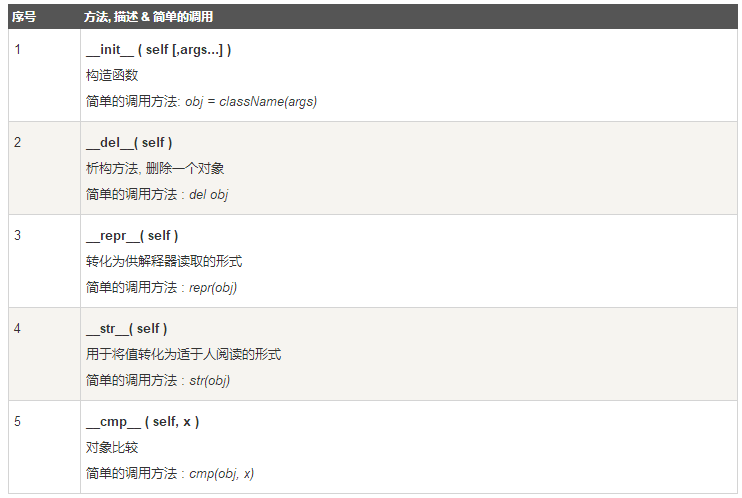下面是一个员工类的创建及类对象的创建实例:
#!/usr/bin/python
# -*- coding: UTF-8 -*-
class Employee: empCount = 0 def __init__(self,name,salary): #构造函数 self.name = name self.salary = salary Employee.empCount += 1 def displayCount(self): print "Total Employee %d " % Employee.empCount def displayEmployee(self): print "Name:" , self.name, ",Salary: ", self.salary emp1 = Employee("yuan", 3000) emp2 = Employee("qiang",4000) #添加属性 emp1.age = 7 emp2.age = 8 #删除对象emp1的属性 #del emp1.age emp2.displayEmployee() print "Total emploeey %d" % Employee.empCount print "emp1 is %d years old" %emp1.age
#python内置类属性 print "Employee.__doc__:",Employee.__doc__ print "Employee.__name__:",Employee.__name__ print "Employee.__module__:",Employee.__module__ print "Employee.__bases__:",Employee.__bases__ print "Employee.__dict__:",Employee.__dict__
执行结果:
Name: yuan ,Salary: 3000
Name: qiang ,Salary: 4000
Total emploeey 2
emp1 is 7 years old
Employee.__doc__: None
Employee.__name__: Employee
Employee.__module__: __main__
Employee.__bases__: ()
Employee.__dict__: {'__module__': '__main__', 'displayCount': <function displayCount at 0x00000000035184A8>, 'empCount': 2, 'displayEmployee': <function displayEmployee at 0x0000000003518518>, '__doc__': None, '__init__': <function __init__ at 0x0000000003518438>}
-
empCount 变量是一个类变量,它的值将在这个类的所有实例之间共享。你可以在内部类或外部类使用 Employee.empCount 访问。
-
第一种方法__init__()方法是一种特殊的方法,被称为类的构造函数或初始化方法,当创建了这个类的实例时就会调用该方法
-
self 代表类的实例,self 在定义类的方法时是必须有的,虽然在调用时不必传入相应的参数。
-
Python内置类属性
- __dict__ : 类的属性(包含一个字典,由类的数据属性组成)
- __doc__ :类的文档字符串
- __name__: 类名
- __module__: 类定义所在的模块(类的全名是'__main__.className',如果类位于一个导入模块mymod中,那么className.__module__ 等于 mymod)
- __bases__ : 类的所有父类构成元素(包含了一个由所有父类组成的元组)
析构函数
析构函数 __del__ ,__del__在对象销毁的时候被调用,当对象不再被使用时,__del__方法运行:
#!/usr/bin/python
# -*- coding: UTF-8 -*-
class Point:
def __init__(self,x = 0,y = 0):
self.x = x
self.y = y
def __del__(self):
class_name = self.__class__.__name__
print class_name ,"销毁"
pt1 = Point()
pt2 = pt1 #引用
pt3 = pt1
print id(pt1),id(pt2),id(pt3) #打印出对象的ID
#调用析构函数进行对象的销毁
del pt1
del pt2
del pt3
执行结果:
45331272 45331272 45331272
Point 销毁
注意:通常你需要在单独的文件中定义一个类,
类的继承
面向对象的编程带来的主要好处之一是代码的重用,实现这种重用的方法之一是通过继承机制。继承完全可以理解成类之间的类型和子类型关系。
需要注意的地方:继承语法 class 派生类名(基类名)://... 基类名写在括号里,基本类是在类定义的时候,在元组之中指明的。
在python中继承中的一些特点:
- 1:在继承中基类的构造(__init__()方法)不会被自动调用,它需要在其派生类的构造中亲自专门调用。
- 2:在调用基类的方法时,需要加上基类的类名前缀,且需要带上self参数变量。区别在于类中调用普通函数时并不需要带上self参数
- 3:Python总是首先查找对应类型的方法,如果它不能在派生类中找到对应的方法,它才开始到基类中逐个查找。(先在本类中查找调用的方法,找不到才去基类中找)。
如果在继承元组中列了一个以上的类,那么它就被称作"多重继承" 。
下面一个类的继承实例:
#!/usr/bin/python
# -*- coding: UTF-8 -*-
class Parent: parentAttr = 100 def __init__(self): print "调用父类构造函数" def parentMethod(self): print "调用父类方法" def setAttr(self,attr): Parent.parentAttr = attr def getAttr(self): print "父类属性:",Parent.parentAttr def aa(self): print "调用父类aa" class Child(Parent): def __init__(self): print "调用子类构造函数" def childMethod(self): print "调用子类方法" def aa(self): print "调用子类aa" c = Child() #实例化子类 c.childMethod() c.parentMethod() c.setAttr(200) c.getAttr() c.aa()
执行结果:
调用子类构造函数
调用子类方法
调用父类方法
父类属性: 200
调用子类aa
多类继承
class A: # 定义类 A
.....
class B: # 定义类 B
.....
class C(A, B): # 继承类 A 和 B
你可以使用issubclass()或者isinstance()方法来检测。
- issubclass() - 布尔函数判断一个类是另一个类的子类或者子孙类,语法:issubclass(sub,sup)
- isinstance(obj, Class) 布尔函数如果obj是Class类的实例对象或者是一个Class子类的实例对象则返回true。
方法重写
如果你的父类方法的功能不能满足你的需求,你可以在子类重写你父类的方法:
#!/usr/bin/python
# -*- coding: UTF-8 -*-
class Parent: # 定义父类
def myMethod(self):
print '调用父类方法'
class Child(Parent): # 定义子类
def myMethod(self):
print '调用子类方法'
c = Child() # 子类实例
c.myMethod() # 子类调用重写方法
执行结果:
调用子类方法
基础重载方法
下表列出了一些通用的功能,你可以在自己的类重写:

运算符重载
Python同样支持运算符重载,实例如下:
#!/usr/bin/python
class Vector:
def __init__(self, a, b):
self.a = a
self.b = b
def __str__(self):
return 'Vector (%d, %d)' % (self.a, self.b)
def __add__(self,other):
return Vector(self.a + other.a, self.b + other.b)
v1 = Vector(2,10)
v2 = Vector(5,-2)
print v1 + v2
执行结果:
Vector (7,8)
类属性与方法
类的私有属性
__private_attrs:两个下划线开头,声明该属性为私有,不能在类的外部被使用或直接访问。在类内部的方法中使用时 self.__private_attrs。
类的方法
在类的内部,使用 def 关键字可以为类定义一个方法,与一般函数定义不同,类方法必须包含参数 self,且为第一个参数
类的私有方法
__private_method:两个下划线开头,声明该方法为私有方法,不能在类地外部调用。在类的内部调用 self.__private_methods
class JustCounter:
__secretCount = 0 #私有成员
publicCount = 0 #公有成员
def count(self):
self.__secretCount += 1
self.publicCount += 1
print self.__secretCount
counter = JustCounter()
counter.count()
counter.count()
print counter.publicCount
#print counter.__secretCount #报错,私有成员,不能通过对象直接进行访问
print counter._JustCounter__secretCount #可以通过object._className__attrName 这样组合的方式进行访问私有成员
执行结果:
1
2
2
2
单下划线、双下划线、头尾双下划线说明:
-
__foo__: 定义的是特殊方法,一般是系统定义名字 ,类似 __init__() 之类的。
-
_foo: 以单下划线开头的表示的是 protected 类型的变量,即保护类型只能允许其本身与子类进行访问,不能用于 from module import *
-
__foo: 双下划线的表示的是私有类型(private)的变量, 只能是允许这个类本身进行访问了。